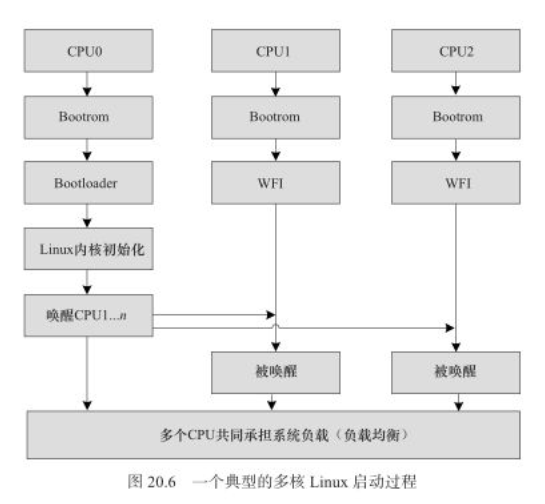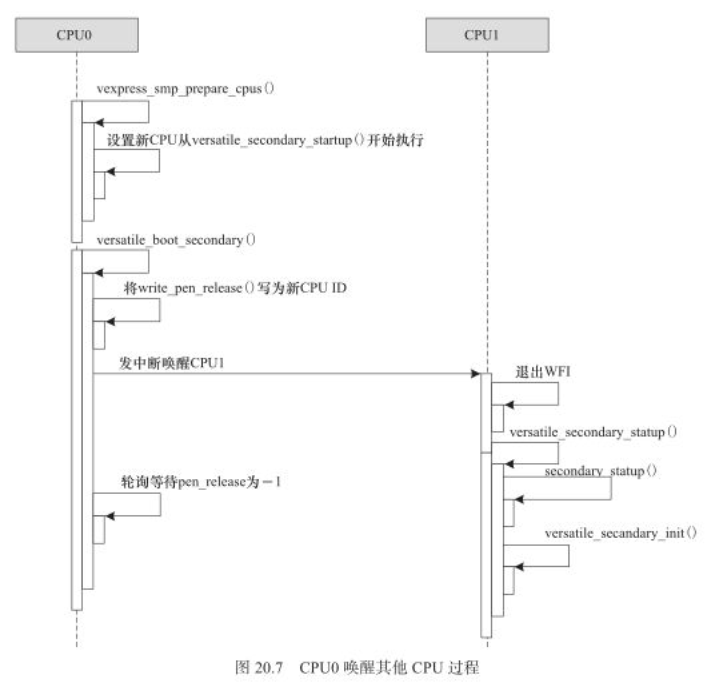转载地址:https://www.cnblogs.com/linhaostudy/p/9371562.html
在 Linux系统中,对于多核的ARM芯片而言,在Biotron代码中,每个CPU都会识别自身ID,如果ID是0,则引导Bootloader和 Linux内核执行,如果ID不是0,则Biotron一般在上电时将自身置于WFI或者WFE状态,并等待CPU0给其发CPU核间中断或事件**(一般通过SEV指令)**以唤醒它。
一个典型的多核 Linux启动过程如图20.6所示。
被CPU0唤醒的CPUn可以在运行过程中进行热插拔,譬如运行如下命令即可卸载CPU1,并且将CPUI上的任务全部迁移到其他CPU中:
# echo 0 > /sys/devices/system/cpu/cpu1/online
同理,运行如下命令可以再次启动CPU1:
# echo 1 > /sys/devices/system/cpu/cpu1/online
之后CPU1会主动参与系统中各个CPU之间的运行任务的负载均衡工作;

CPU0唤醒其他CPU的动作在内核中被封装为一个 smp_operations的结构体,对于ARM而言,它定义于 arch/arm/include/asm/smp.h中。该结构体的成员函数如代码清单所示。
struct smp_operations {
#ifdef CONFIG_SMP
/*
* Setup the set of possible CPUs (via set_cpu_possible)
*/
void (*smp_init_cpus)(void);
/*
* Initialize cpu_possible map, and enable coherency
*/
void (*smp_prepare_cpus)(unsigned int max_cpus);
/*
* Perform platform specific initialisation of the specified CPU.
*/
void (*smp_secondary_init)(unsigned int cpu);
/*
* Boot a secondary CPU, and assign it the specified idle task.
* This also gives us the initial stack to use for this CPU.
*/
int (*smp_boot_secondary)(unsigned int cpu, struct task_struct *idle);
#ifdef CONFIG_HOTPLUG_CPU
int (*cpu_kill)(unsigned int cpu);
void (*cpu_die)(unsigned int cpu);
int (*cpu_disable)(unsigned int cpu);
#endif
#endif
};
通过这个宏进行声明注册(有点像ATF的服务注册)
DT_MACHINE_START(VEXPRESS DT,"ARM-Versatile Express)
.dt_compat = v2m_dt_match,
.smp = smp_ops(express_smp_ops),
.map_io = v2m_dt_map_io,
MACHINE_END
通过 arch/arm/mach-vexpress/platsmp.c的实现代码可以看出, smp_operations的成员函数smp_init_cpus(),即 vexpress_smp_init_cpus调用的ct_ca9x4_init_cpu_map(会探测SoC内CPU核的个数,并通过 set_cpu_possible设置这些CPU可见。
而 smp_operations的成员函数 smp_prepare_cpus,即 vexpress_smp_prepare_cpus则会通过v2m_flags_set( virt_to_phys( versatile_secondary_startup)设置其他CPU的启动地址为versatile_secondary_startup,如代码清单所示。
在smp_prepare_cpus()设置CPU1…n启动地址:
static void __init vexpress_smp_prepare_cpus(unsigned int max_cpus)
{
/*
* Initialise the present map, which describes the set of CPUs
* actually populated at the present time.
*/
if (ct_desc)
ct_desc->smp_enable(max_cpus);
else
vexpress_dt_smp_prepare_cpus(max_cpus);
/*
* Write the address of secondary startup into the
* system-wide flags register. The boot monitor waits
* until it receives a soft interrupt, and then the
* secondary CPU branches to this address.
*/
vexpress_flags_set(virt_to_phys(versatile_secondary_startup));
}
注意这部分具体实现方式是与SOC相关的,由芯片设计及芯片内部的Bootrom决定。对于VEXPRESS来讲,设置方法如下:
void __init v2m_flags_set(u32 data)
{
writel(~0, v2m_sysreg_base + V2M_SYS_FLAGSCLR);
writel(data, v2m_sysreg_base + V2M_SYS_FLAGSCLR);
}
即填充 v2m_sysreg_base+V2M_SYS_FLAGSCLR标记清除寄存器为0xFFFFFFFF,将CPU1…n初始启动执行的指令地址填入v2m_sysreg_base+V2M_SYS_FLAGSSET寄存器。
这两个地址由芯片内部的Bootrom程序设定的。填入的CPU1…n的起始地址都通过virt_to_phys转化为物理地址,因为此时CPU1…n的MMU尚未开启;
比较关键的是smp_operations的成员函数smp_boot_secondary(),它是完成CPU最终唤醒的工作,对于本例而言,versatile_boot_secondary();
CPU0通过终端唤醒其他CPU:
/*
* Write pen_release in a way that is guaranteed to be visible to all
* observers, irrespective of whether they're taking part in coherency
* or not. This is necessary for the hotplug code to work reliably.
*/
static void __cpuinit write_pen_release(int val)
{
pen_release = val;
smp_wmb();
__cpuc_flush_dcache_area((void *)&pen_release, sizeof(pen_release));
outer_clean_range(__pa(&pen_release), __pa(&pen_release + 1));
}
int __cpuinit versatile_boot_secondary(unsigned int cpu, struct task_struct *idle)
{
unsigned long timeout;
/*
* Set synchronisation state between this boot processor
* and the secondary one
*/
spin_lock(&boot_lock);
/*
* This is really belt and braces; we hold unintended secondary
* CPUs in the holding pen until we're ready for them. However,
* since we haven't sent them a soft interrupt, they shouldn't
* be there.
*/
write_pen_release(cpu_logical_map(cpu));
/*
* Send the secondary CPU a soft interrupt, thereby causing
* the boot monitor to read the system wide flags register,
* and branch to the address found there.
*/
arch_send_wakeup_ipi_mask(cpumask_of(cpu));
timeout = jiffies + (1 * HZ);
while (time_before(jiffies, timeout)) {
smp_rmb();
if (pen_release == -1)
break;
udelay(10);
}
/*
* now the secondary core is starting up let it run its
* calibrations, then wait for it to finish
*/
spin_unlock(&boot_lock);
return pen_release != -1 ? -ENOSYS : 0;
}
调用的 write_pen_release会将 pen_release变量设置为要唤醒的CPU核的CPU号 cpu_logical_map(cpu),
而后通过 arch_send_wakeup_ipi mask给要唤醒的CPU发IPI中断,这个时候,被唤醒的CPU会退出WFI状态并从前面 smp_operations中的smp_prepare_cpus成员函数,即 vexpress_smp_prepare_cpus里通过 v2m_flags_set()设置的起始地址 versatile_secondary_startup开始执行,
如果顺利的话,该CPU会将原先为正数的pen_release写为-1,以便CPU0从等待pen_release成为-1的循环跳出;
versatile_secondary_startup实现于arch/arm/plat-versatile/headsmp.S中,是一段汇编,如下代码所示:
/*
* Realview/Versatile Express specific entry point for secondary CPUs.
* This provides a "holding pen" into which all secondary cores are held
* until we're ready for them to initialise.
*/
ENTRY(versatile_secondary_startup)
mrc p15, 0, r0, c0, c0, 5
bic r0, #0xff000000
adr r4, 1f
ldmia r4, {r5, r6}
sub r4, r4, r5
add r6, r6, r4
pen: ldr r7, [r6]
cmp r7, r0
bne pen
/*
* we've been released from the holding pen: secondary_stack
* should now contain the SVC stack for this core
*/
b secondary_startup
.align
1: .long .
.long pen_release
ENDPROC(versatile_secondary_startup)
上述循环代码的循环是等待pen_release变量称为CPU0设置的cpu_logical_map(cpu),一般就直接成立了。
第16行调用内核通用的secondary_startup()函数,经过一系列初始化(如MMU等),最终新的被唤醒的CPU将调用smp_operations的smp_secondary_init()的成员函数,对于本例为versatile_secondary_init();
void __cpuinit versatile_secondary_init(unsigned int cpu)
{
/*
* let the primary processor know we're out of the
* pen, then head off into the C entry point
*/
write_pen_release(-1);
/*
* Synchronise with the boot thread.
*/
spin_lock(&boot_lock);
spin_unlock(&boot_lock);
}
上述代码会将pen_release写为-1,于是CPU0还在执行代码的versatile_boot_secondary()函数中的如下循环就退出了:
timeout = jiffies + (1 * HZ);
while (time_before(jiffies, timeout)) {
smp_rmb();
if (pen_release == -1)
break;
udelay(10);
}
这样CPU0就知道目标CPU已经被正确地唤醒,此后CPU0和新唤醒的其他CPU各自运行。整个系统在运行过程中会进行实时进程和正常进程的动态负载均衡。
下图总结了前文提到的vexpress_smp_prepare_cpus()、versatile_boot_secondary()、write_pen_release()、versatile_secondary_startup()、versatile_secondary_init()这些函数的执行顺序;






















 7830
7830











 被折叠的 条评论
为什么被折叠?
被折叠的 条评论
为什么被折叠?








